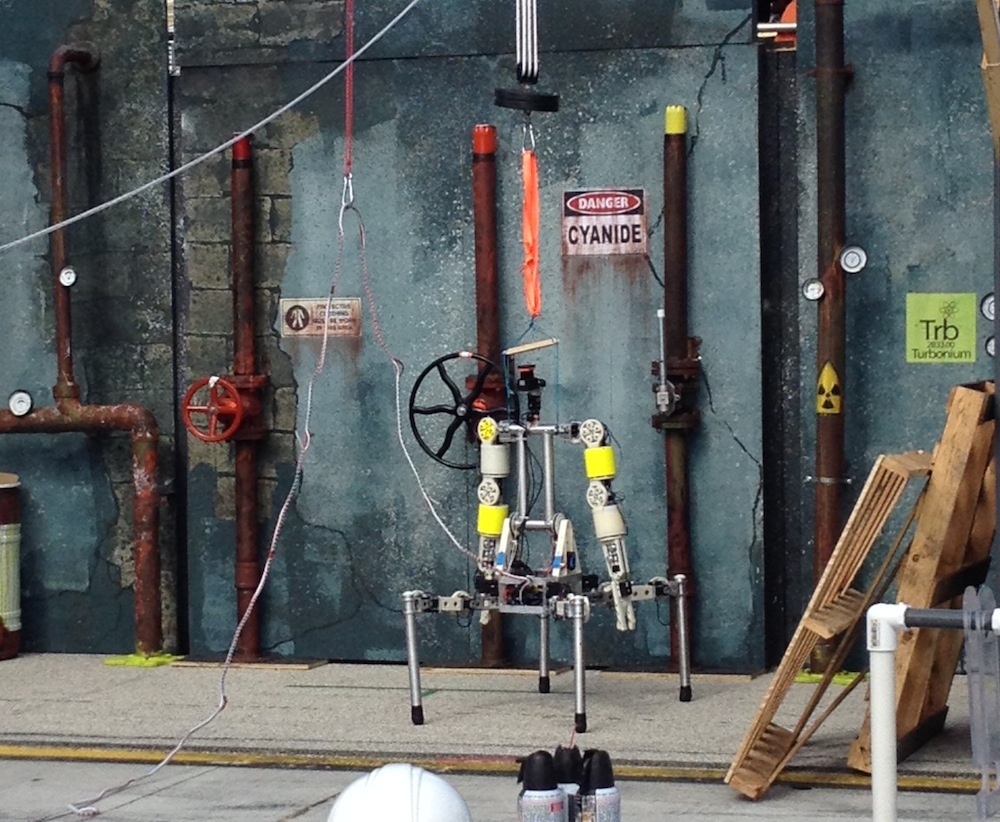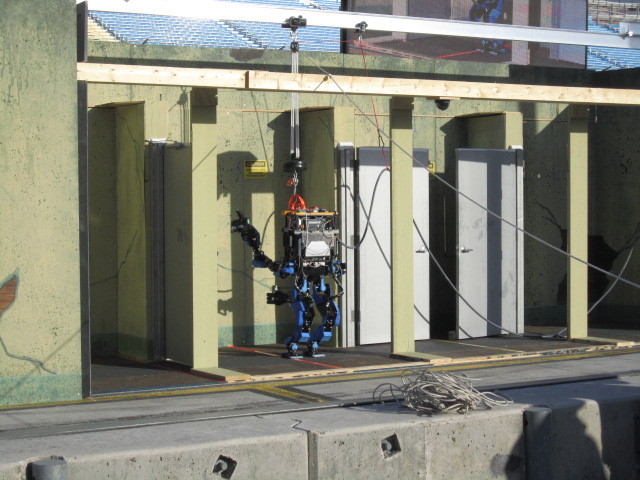Robots of the Future: Q&A With DARPA Director Arati Prabhakar

HOMESTEAD, Fla. — For the past two days, engineering teams from around the world have been competing in a unique competition that showcases some of the most advanced capabilities in the field of robotics.
The two-day DARPA Robotics Challenge Trials began Friday (Dec. 20) here at the Homestead Miami Speedway. The competition is designed to test the robots' ability to perform disaster-response tasks, such as clearing pieces of debris, driving a vehicle, traversing uneven terrain and climbing a ladder.
Seventeen teams qualified for the contest, and the highest-scoring groups will move on to the DARPA Robotics Finals next year. As robots battled through each phase of the Trials, LiveScience sat down with DARPA director Arati Prabhakar to talk about the competition, the future of robotics, and how robots relate to national defense. [Images: Meet the DARPA Robotics Challengers]
LiveScience: What are DARPA's goals for the outcome of the Robotics Challenge?
A.P.: The Challenges are just one piece of how we do our business. Our mission, and everything that we do, is breakthrough technologies for national security. But, we want to be able to work with the broad technical community in a lot of different ways. In the last decade or so, we've had this new capability — Challenges — that we've used to tremendous effect.
Disaster relief is a problem that just stares you in the face: Here are these terribly challenging situations, hazardous conditions — wouldn't it be great if we had robotic capabilities that could help us with that, and alleviate these dangerous tasks for human beings? When we started down this path, we knew there was a lot of great research brewing. But, the purpose of the Challenge is to put a task out in front of these teams that really requires them to pull all those pieces together and actually build a robotic capability that can execute the task. It's a wonderful forcing function to get beyond just tuning the individual pieces of the technology. This is a great example of exactly where Challenges can be very, very helpful.

LS: As you walked around here, what were your impressions of the Challenge so far?
Sign up for the Live Science daily newsletter now
Get the world’s most fascinating discoveries delivered straight to your inbox.
A.P.: Gill Pratt, the program manager for the effort, has done a great job of trying to explain to people that it's very early days, and that what you see in the movies is not what we're actually able to do yet with humanoid robots. He talked about the Wright Brothers and their first flight, and how it was only 7 miles an hour. It's so amazing to think about, since many of us flew down here. It's remarkable to think about how far we've come in that century. [Images: Cross-Country Flight in a Solar-Powered Plane]
With all of that in mind, I have to say, when you watch these robots trying to do these complex tasks, it's still sort of remarkable how slowly they move. We were watching the ladder task, and I think for the five or seven minutes that I was standing there watching, what we were watching was a robot contemplating the ladder, trying to figure it out so it could start walking up this thing. It just makes you realize how the things we take for granted are so complex when you have to program something to do it.
LS: Have you been surprised by anything in the competition?
A.P.: I've been intrigued by the variety of different types of robots. First of all, there's a huge variety of humanoid shapes — different proportions and different emphases on strength and dexterity. But there are a few that don't even look humanoid. I love seeing the creativity and lots of different ways the teams are approaching the challenge.
LS: The robots on display move very slowly, but how difficult is it to have these machines carry out some of the tasks in this contest?
A.P.: It is very challenging. The robots that we know are robots in manufacturing. In the military, we've also used robots to help deal with improvised explosive devices, but what's different here is, to do disaster-response tasks requires robots that can operate in an environment that has been designed by human beings. Things that are very simple for us — getting into a vehicle, opening a door and walking through it, or just moving through an obstacle course — for robots, these are incredibly complex tasks.
I think it's also the reason you see a number of the competitors have robots that do look somewhat humanoid, because having limbs and the ability to move in those ways is what it takes to be able to deal with this human-designed environment.
LS: When might we realistically see these types of robots working with humans in disaster-response situations?
A.P.: It's very hard to predict with precision a date by which a certain capability will exist, so I won't. While I think it's hard to be precise about when, and in exactly what form, when I look at what we're seeing out here, as nascent as it is, I can imagine that we are going to get to a future where some of these kinds of capabilities will be robots that help us with these very hazardous tasks in the future.

LS: How does DARPA try to take the research that happens in labs and translate that into practical applications?
A.P.: I think Challenges help, and the reason is that a Challenge shows people what's possible. It's very different to see a robot executing one of these tasks. Compare that to reading a research paper that describes how a control system works, or how robotic manipulation of limbs works. Those are such important research components, but when you actually see it happening before your eyes, then you know what you've got. You know what's real. And that's true in much of what DARPA does, whether it's Challenges or otherwise. We often think of our job, our mission, as being to show people what's possible, because that's what changes the future. I do think Challenges are a great part of helping with that.
LS: Does this challenge equalize the playing field in robotics? What kinds of organizations benefit from these contests?
A.P.: It's always part of our work to make sure that we reach people that have innovative ideas or new approaches, or the ability to put systems together in better ways. We are always trying to reach people out beyond the traditional communities. I tell my program mangers: If we just sit in our offices in Arlington, Virginia, and we just listen to what comes through our doors, we're not doing our jobs. So we get out and we go find people who are working in small companies; working in the commercial industry who might not be thinking about national security issues; people in universities of all sorts; labs of all sorts. This challenge has given us a great opportunity to engage teams from countries around the world. That's just part and parcel of how we do our job at DARPA.
In this particular challenge, I think the challenge model has exactly that benefit. People have lots of preconceived notions about who's really going to be good at doing x, y and z. People can have all the theories they want, but when you actually have a competition, you see who can do what. I think it's very empowering to lots of people. [Super-Intelligent Machines: 7 Robotic Futures]
LS: This contest focuses on disaster-response robots, but do these technologies also have national security applications?
A.P.: Absolutely, there will be. The "D" in DARPA is "Defense." We have always been part of the Defense Department, and our core mission is breakthrough technologies for national security. We know from five-and-a-half decades of our history that some of the biggest impacts we provide for national security come through broad enabling technologies that often have huge commercial markets as well. We don't pursue those. We often spark interest in those areas and then companies go pursue them, and sometimes huge industries come out of that. If you look across information technology today, you can trace much of that work to early seeds that we planted.
This becomes an important capability that we can then help harvest for DoD needs and national security needs. Robotics, I think, is very similar. It's easy to imagine commercial applications over time. In the military context, our warfighters have to do incredibly dangerous tasks as a core part of their missions. As robotics technology advances and we can harvest it to help alleviate those challenges for our warfighters, that's absolutely something we will be looking to do.
Follow Denise Chow on Twitter @denisechow. Follow LiveScience @livescience, Facebook & Google+. Original article on LiveScience.

Denise Chow was the assistant managing editor at Live Science before moving to NBC News as a science reporter, where she focuses on general science and climate change. Before joining the Live Science team in 2013, she spent two years as a staff writer for Space.com, writing about rocket launches and covering NASA's final three space shuttle missions. A Canadian transplant, Denise has a bachelor's degree from the University of Toronto, and a master's degree in journalism from New York University.










